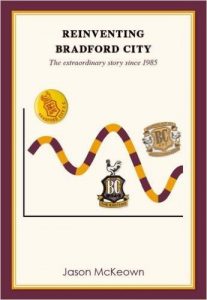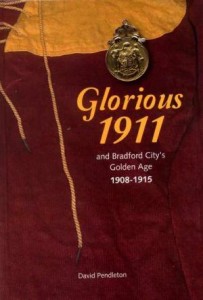Book Review: Reinventing Bradford City by Jason McKeown
 Reinventing Bradford City is the second part of a four volume series under the banner of History Revisited from Bantamspast. The first book was the well received, A History of Bradford City AFC in Objects, by John Dewhirst published in 2014.
Reinventing Bradford City is the second part of a four volume series under the banner of History Revisited from Bantamspast. The first book was the well received, A History of Bradford City AFC in Objects, by John Dewhirst published in 2014.
This second offering written by Jason McKeown is described as, “the story of how Bradford City emerged from the dark shadows of May 11, 1985 (the date of the Bradford City Fire), and how they have evolved in these modern times. How they have continued to re-invent themselves, in both good ways and bad.”
McKeown’s central device for doing this is to look at thirteen fixtures which span the 1986/87 season through to the 2015/16 campaign. The author’s point of reference for selecting the particular games is not always that they were fixtures that the Bantams excelled in, rather than they had a significance or relevance to the club at that point in time. So whilst you will find included the games in which City were promoted to the Premier League at Wolves and the FA Cup win at Chelsea where the Bantams came back from 2-0 to triumph 4-2, equally the reader will find the 1987/88 play-off loss to Ipswich Town.
What McKeown does well is ensure that the games featured aren’t isolated as in mere match report format, instead the context for them is provided and their overall significance at that moment in time, with if relevant, the link and impact to future events at Valley Parade. The author’s writing is supported by good research and plenty of material through interviews with players, managers (past and present), fans and the like, for their take on the events of the period between 1986 and 2016.
The book is a wonderful reflection of a thirty year period and the incredible highs and lows of this club from West Yorkshire. The spells in administration, the years spent in the basement division of the Football League, the Play-Off triumphs, the brief sojourn in the Premier League, the League Cup appearance at Wembley, the win at Chelsea in the FA Cup are all here – all dealt with in a pragmatic manner that typifies Bradford City AFC.
This is a story of a club that emerged from a disaster to write another incredible chapter in its history. However, as McKeown quite rightly points out, as he reflects on the last game featured in the book against Oldham Athletic at Valley Parade in January 2016, the thirty year period detailed in the book are merely a point in time. In essence, Bradford City had a history before 1986 and will have a history after 2016, with twists and turns and ups and downs aplenty.
To make the point, for that 2016 Oldham game, the Bantams were still managed by Phil Parkinson, with Mark Lawn and Julian Rhodes at the helm. By May 2016 the German pair of Edin Rahic and Stefan Rupp owned the club and a month later the Parkinson era was over as he moved to Bolton Wanderers. Stuart McCall returned once again to answer the call of his beloved Bradford City and so another chapter had begun.
